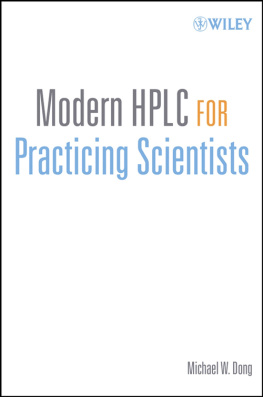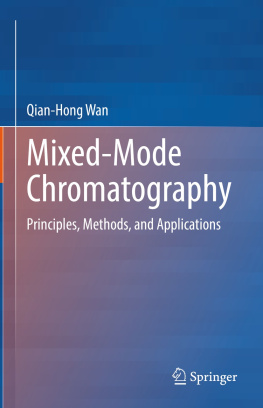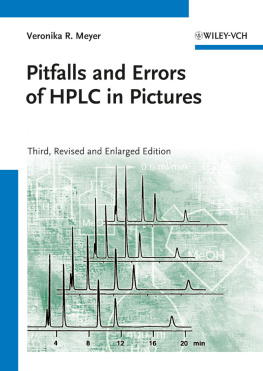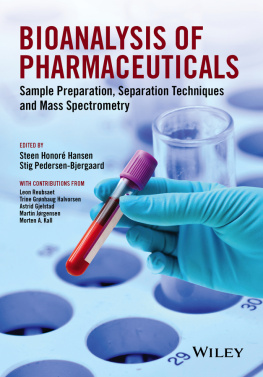MODERN HPLC FOR PRACTICING SCIENTISTS
Copyright 2006 by John Wiley & Sons, Inc. All rights reserved.
Published by John Wiley & Sons, Inc., Hoboken, New Jersey.
Published simultaneously in Canada.
No part of this publication may be reproduced, stored in a retrieval system, or transmitted in any form or by any means, electronic, mechanical, photocopying, recording, scanning, or otherwise, except as permitted under Section 107 or 108 of the 1976 United States Copyright Act, without either the prior written permission of the Publisher, or authorization through payment of the appropriate per-copy fee to the Copyright Clearance Center, Inc., 222 Rosewood Drive, Danvers, MA 01923, (978) 750-8400, fax (978) 750-4470, or on the web at www.copyright.com . Requests to the Publisher for permission should be addressed to the Permissions Department, John Wiley & Sons, Inc., 111 River Street, Hoboken, NJ 07030, (201) 748-6011, fax (201) 748-6008, or online at http://www.wiley.com/go/permission .
Limit of Liability/Disclaimer of Warranty: While the publisher and author have used their best efforts in preparing this book, they make no representations or warranties with respect to the accuracy or completeness of the contents of this book and specifically disclaim any implied warranties of merchantability or fitness for a particular purpose. No warranty may be created or extended by sales representatives or written sales materials. The advice and strategies contained herein may not be suitable for your situation. You should consult with a professional where appropriate. Neither the publisher nor author shall be liable for any loss of profit or any other commercial damages, including but not limited to special, incidental, consequential, or other damages.
For general information on our other products and services or for technical support, please contact our Customer Care Department within the United States at (800) 762-2974, outside the United States at (317) 572-3993 or fax (317) 572-4002.
Wiley also publishes its books in a variety of electronic formats. Some content that appears in print may not be available in electronic formats. For more information about Wiley products, visit our web site at www.wiley.com .
Library of Congress Cataloging-in-Publication Data:
Dong, M. W.
Modern HPLC for practicing scientists / by Michael W. Dong.
p. cm.
Includes bibliographical references and index.
ISBN-13: 978-0-471-72789-7
ISBN-10: 0-471-72789-X
1. High performance liquid chromatography. 2. DrugsAnalysis. I. Title.
RS189.5.H54D66 2006
615.19dc22
2005057463
PREFACE
The idea for writing this basic HPLC book was probably born in the New York City subway system while I was a graduate student in the 1970s. Amidst the rumbling noise of the subway, I was reading the green bookBasic Gas Chromatography by McNair and Bonnelliand was immediately impressed with its simplicity and clarity. In the summer of 2004, I had just completed the editing of Handbook of Pharmaceutical Analysis by HPLC with Elsevier/Academic Press, and was toying with the idea of starting a book project on Fast LC and high-throughput screening. Several phone conversations with Heather Bergman, my editor at Wiley, convinced me that an updated book on modern HPLC, modeled after the green book, would have more of an impact.
This book was written with a sense of urgency during weekends and weekday evenings through snow storms, plane trips, allergy seasons, company restructuring, and job changes. The first draft was ready in only 10 months because I was able to draw many examples from my previous publications and from my short course materials for advanced HPLC in pharmaceutical analysis given at national meetings. I am not a fast writer, but rather a methodical one who revised each chapter many times before seeking review advice from my friends and colleagues. My goal was to provide the reader with an updated view of the concepts and practices of modern HPLC, illustrated with many figures and case studies. My intended audience was the practicing scientistto provide them with a review of the basics as well as best practices, applications, and trends of this fast-evolving technique. Note that this basic book for practitioners was written at both an introductory and intermediate level. I am also targeting the pharmaceutical analysts who constitute a significant fraction of all HPLC users. My focus was biased towards reversed-phase LC and pharmaceutical analysis. The scope of this book does not allow anything more than a cursory mention of the other applications.
Writing a book as a sole author was a labor of love, punctuated with flashes of inspiration and moments of despair. It would have been a lonely journey without the encouragement and support of my colleagues and friends. First and foremost, I would like to acknowledge the professionalism of my editor at John Wiley, Heather Bergman, whose enthusiasm and support made this a happy project. I also owe much to my reviewers, including the 10 reviewers of the book proposal, and particularly to those whose patience I tested by asking them to preview multiple chapters. They have given me many insights and valuable advice. The list of reviewers is long:
Prof. David Locke of City University of New York (my graduate advisor); Prof. Harold McNair of Virginia Tech, whose green book provided me with a model; Prof. Jim Stuart of University of Connecticut; Drs. Lloyd Snyder and John Dolan of LC Resources; Drs. Raphael Ornaf, Cathy Davidson, and Danlin Wu, and Joe Grills, Leon Zhou, Sung Ha, and Larry Wilson of Purdue Pharma; Dr. Ron Kong of Synaptic; Drs. Uwe Neue, Diane Diehl, and Michael Swartz of Waters Corporation, Wilhad Reuter of PerkinElmer; Drs. Bill Barbers and Thomas Waeghe of Agilent Technologies; Drs. Krishna Kallary and Michael McGinley of Phenomenex; Dr. Tim Wehr of BioRad; John Martin and Bill Campbell of Supelco; Dr. Andy Alpert of PolyLC; Margie Dix of Springborn-Smithers Laboratories; Dr. Linda Ng of FDA, CDER; and Ursula Caterbone of MacMod.
Finally, I acknowledge the support and the unfailing patience of my wife, Cynthia, and my daughter, Melissa, for putting up with my long periods of distraction when I struggled for better ways for putting ideas on paper. To them, I pledge more quality time to come after 2006.
Norwalk, Connecticut
MICHAEL W. DONG
Chapter 1
INTRODUCTION
1.1 INTRODUCTION
1.1.1 Scope
High-performance liquid chromatography (HPLC) is a versatile analytical technology widely used for the analysis of pharmaceuticals, biomolecules, polymers, and many organic and ionic compounds. There is no shortage of excellent books on chromatography1,2 and on HPLC,39 though many are outdated and others cover academic theories or specialized topics. This book strives to be a concise text that capsulizes the essence of HPLC fundamentals, applications, and developments. It describes basic theories and terminologies for the novice and reviews relevant concepts, best practices, and modern trends for the experienced practitioner. While broad in scope, this book focuses on reversed-phase HPLC (the most common separation mode) and pharmaceutical applications (the largest user segment). Information is presented in a straightforward manner and illustrated with an abundance of diagrams, chromatograms, tables, and case studies and supported with selected key references or web resources.









